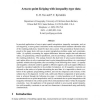Free Online Productivity Tools
i2Speak
i2Symbol
i2OCR
iTex2Img
iWeb2Print
iWeb2Shot
i2Type
iPdf2Split
iPdf2Merge
i2Bopomofo
i2Arabic
i2Style
i2Image
i2PDF
iLatex2Rtf
Sci2ools
JGS
2006
2006
Area-to-point Kriging with inequality-type data
In practical applications of area-to-point spatial interpolation, inequality constraints, such as non-negativity, or more general constraints on the maximum and/or minimum allowable value of the resulting predictions, should be taken into account. The geostatistical framework proposed in this paper deals with area-to-point interpolation problems under such constraints, while: (i) explicitly accounting for support differences between sample data and unknown values, (ii) guaranteeing coherent predictions, and (iii) providing a measure of reliability for the resulting predictions. The analogy between the dual form of area-to-point interpolation and a spline allows to solve constrained area-to-point interpolation problems via a constrained quadratic minimization algorithm, after accounting for the following three issues: (i) equality and inequality constraints could be applied to different supports, and such support differences should be considered explicitly in the problem formulation, (...
| Added | 13 Dec 2010 |
| Updated | 13 Dec 2010 |
| Type | Journal |
| Year | 2006 |
| Where | JGS |
| Authors | E.-H. Yoo, Phaedon C. Kyriakidis |
Comments (0)

